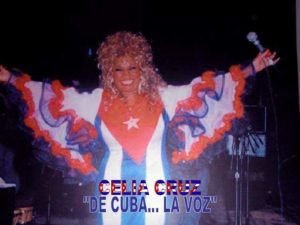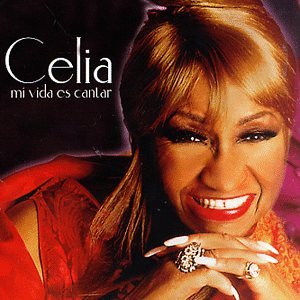 CELIA CRUZ “LA REINA DE LA SALSA” QUE NUNCA OLVIDAMOS. VIDEOS
CELIA CRUZ “LA REINA DE LA SALSA” QUE NUNCA OLVIDAMOS. VIDEOS
Úrsula Hilaria Celia de la Caridad Cruz Alfonso, solo conocida como Celia Cruz, nació el 21 de octubre de 1925 en La Habana, Cuba. Ella era la segunda de 4 hijos y uno de los 14 niños en su hogar extendido.
Al crecer en la década de 1930, sus influencias musicales iban desde su ídolo vocalista afrocubana Paulina Alverez hasta el prolífico compositor Arsenio Rodríguez. Aunque su padre deseaba que ella se convirtiera en maestra (lo cual consiguio), Cruz continuó en un camino musical cantando para varias estaciones de radio. En aquellos días, actuar para la radio era una forma común de entrar en la industria de la música. Estaba destinada a convertirse en una gran estrella.
De hecho, ganó más concursos de radio y se inscribió en el Conservatorio de música de Cuba en 1947, donde estudió piano, teoría de la música y voz. En el camino, desarrolló relaciones importantes con los músicos y productores influyentes de la época. Esto la llevó a su primer gran avance en 1950 cuando fue seleccionada para ser la cantante principal de La Sonora Matancera, una famosa orquesta cubana.
Ella debía ser moldeada para siempre por sus experiencias en los 15 años con La Sonora Matancera. Fue durante esto que explotó en el estrellato y recorrió el mundo. Y fue en la banda donde conoció a su eventual esposo y compañero de toda la vida, Pedro Knight.
La década de 1950 fue un momento bullicioso en la historia de Cuba. Se hizo mundialmente conocido por su vida nocturna y espectáculos de teatro. La discoteca más famosa de la época era The Tropicana. Cruz actuó allí muchas veces y le dio la oportunidad de desarrollar su personalidad musical fuera de La Sonora Matancera.
Pero la década de 1950 en Cuba también fue un momento turbulento forjado con inestabilidad política. Fidel Castro estaba a punto de tomar el poder en una revolución. El 15 de julio de 1960, Cruz dejó su tierra natal cubana para que Estados Unidos nunca volviera. Pero siempre Cuba estuvo presente en cada una de sus presentaciones artísticas.
En 1965, dejó La Sonora Matancera para comenzar una carrera en solitario haciendo equipo con el legendario jugador de timbales, Tito Puente. Luego grabaron 8 discos juntos. Aunque no tuvo grandes éxitos durante este tiempo, logró colaborar con grandes de la salsa como Oscar D’Leon y Héctor Rodríguez, entre otros.
Finalmente llegó a lo grande en los Estados Unidos en 1974 con el clásico álbum de Salsa con Johnny Pacheco, Celia y Johnny. Muchos consideran que este es el mejor álbum de salsa de todos los tiempos y el punto culminante de su carrera. Celia pronto comenzaría a aparecer con la aclamada Fania All-Stars nuevamente recorriendo el mundo.
La década de 1980 fue una década lenta para Cruz, pero ella continuó haciendo música. En 1992, apareció en la película The Mambo Kings y su popularidad una vez más se elevó a niveles sin precedentes. Ahora en sus 60 y 70, comenzó a ser reconocida por su increíble cuerpo de trabajo. Recibió una estrella en el Paseo de la Fama de Hollywood, un premio al logro de toda la vida del Smithsonian, y la Medalla Nacional de las Artes que le otorgó el presidente Bill Clinton. Ella también tiene una calle que lleva su nombre en Miami.
Aparecería en varias películas más y cantaría con músicos aún más increíbles. Ella continuó actuando hasta su muerte el 16 de julio de 2003 cuando sucumbió a un tumor cerebral.
El legado de Celia Cruz no puede ser subestimado. Al final, grabó más de 50 álbumes, de los cuales más de 20 alcanzaron el estado de oro y ganó un total de 3 premios Grammy y 4 premios Grammy Latinos.
Celia Cruz trascendió la música, una verdadera pionera siendo una de las únicas mujeres en Salsa. Derribó barreras de raza y sexismo y unió a la gente. Recuerde que ella vino a los Estados Unidos como una mujer afrocubana durante las luchas por los derechos civiles de la década de 1960. Y Cruz celebró con orgullo su negrura a menudo cantando sobre eso en su música y luciendo afroamericanos y coloridos caftanes africanos en el escenario. Cruz pasó mucho tiempo en el vestuario y tenía un increíble sentido de la moda, siempre vistiendo disfraces deslumbrantes, maquillaje y accesorios. Vea que parte de su ropa de su camerino se exhibe en el Museo Nacional Smithsonian de Historia Americana.
Celia era una mujer hermosa y segura llena de vida. En el escenario, trajo una presencia dominante y un carisma y sentido del humor inigualables. Su pasión por la música, su ritmo impecable, su estilo de improvisación y su poderosa voz enviarían a la multitud a una fiesta de baile. Quincy Jones dijo elocuentemente: “La música de una persona nunca puede ser más o menos de lo que es como ser humano y eso es lo poderoso de Celia. Su música es quien es, hasta el fondo. ”Ella era un alma verdaderamente única; nunca habrá otra Celia Cruz.
 CELIA CRUZ “THE SALSA QUEEN” THAT WE NEVER FORGET. VIDEOS.
CELIA CRUZ “THE SALSA QUEEN” THAT WE NEVER FORGET. VIDEOS.
Úrsula Hilaria Celia de la Caridad Cruz Alfonso only known as Celia Cruz was born on October 21st, 1925 in Havana, Cuba. She was the 2nd of 4 children and one of the 14 children in her extended household.
Growing up in the 1930s her musical influences ranged from her idol Afro-Cuban vocalist Paulina Alverez to the prolific composer Arsenio Rodríguez. Although her father wished for her to become a teacher (that she was), Cruz continued on a musical path by singing for several radio stations. In those days, performing for radio was a common way to break into the music industry. She was destined to become a big star.
Indeed, she went on to win more radio contests and enrolled in Cuba’s Conservatory of music in 1947 where she studied piano, music theory, and voice. Along the way, she developed important relationships with the musicians and influential producers of that time. This led to her first major breakthrough in 1950 when she was selected to be the lead singer for La Sonora Matancera, a famous Cuban orchestra.
She was to be forever shaped by her experiences in the 15 years with La Sonora Matancera. It was during this she exploded into stardom and toured the world. And it was in the band that she met her eventual husband and lifelong companion, Pedro Knight.
The 1950s was a bustling time in Cuba’s history. It became world-renowned for its nightlife and theater shows. The most famous nightclub at the time was The Tropicana. Cruz performed there many times and it gave her a chance to develop her musical personality outside of La Sonora Matancera.
But the 1950’s Cuba was also a turbulent time wrought with political instability. Fidel Castro was about to take power in a revolution. On July 15th, 1960, Cruz left her Cuban homeland for the United States never to return. But always Cuba was present in each of her artistic presentations.
In 1965, she left La Sonora Matancera to start a solo career teaming up with the legendary timbales player, Tito Puente. They went on to record 8 records together. Although she didn’t have any major successes during this time, she got to collaborate with Salsa greats like Oscar D’Leon and Hector Rodriquez, among others.
She finally hit it big in the United States in 1974 with the classic Salsa album with Johnny Pacheco, Celia, and Johnny. Many consider this to be the greatest Salsa album of all time and the highlight of her career. Celia would soon begin appearing with the critically acclaimed Fania All-Stars again touring the world.
The 1980s was a slow decade for Cruz, but she continued to make music. In 1992, she appeared in the film The Mambo Kings and her popularity once again rose to unprecedented levels. Now in her 60’s and 70’s, she began to be recognized for her incredible body of work. She received a star on the Hollywood Walk of Fame, a lifetime achievement award from the Smithsonian, and the National Medal of Arts presented to her by President Bill Clinton. She also has a street named after her in Miami.
She would appear in several more films and sing with yet more amazing musicians. She continued to perform right up to her death on July 16th, 2003 when she succumbed to a brain tumor.
Celia Cruz’s legacy can not be understated. In the end, she recorded over 50 albums of which more than 20 reached gold status and winning a total of 3 Grammy Awards and 4 Latin Grammy Awards.
Celia Cruz transcended music, a true trailblazer being one of the only women in Salsa. She knocked down barriers of race and sexism and brought people together. Remember she came to the United States as an Afro-Cuban woman during the civil rights struggles of the 1960s. And Cruz proudly celebrated her blackness often singing about it in her music and sporting Afros and colorful African caftans on stage. Cruz spent a lot of time in the dressing room and had an incredible sense of fashion, always wearing glitzy costumes, makeup, and accessories. See some of her clothes from her dressing room is on display at the Smithsonian National Museum of American History.
Celia was a beautiful and confident woman full of life. On stage, she brought a commanding presence and an unmatched charisma and sense of humor. Her passion for music, impeccable rhythm, improvisational style, and powerful voice would send the crowd into a dance party. Quincy Jones eloquently stated, “A person’s music can never be more or less than what they are as a human being and that’s what’s powerful about Celia. Her music is who she is, down to the rock bottom.” She was a truly unique soul; there will never be another Celia Cruz.
Agencies/ Wiki/ CeliaBio/ Internet Photos/ Extractos/ Excerpts/ YouTube/ Arnoldo Varona/ www.TheCubanhistory.com
THE CUBAN HISTORY, HOLLYWOOD.










